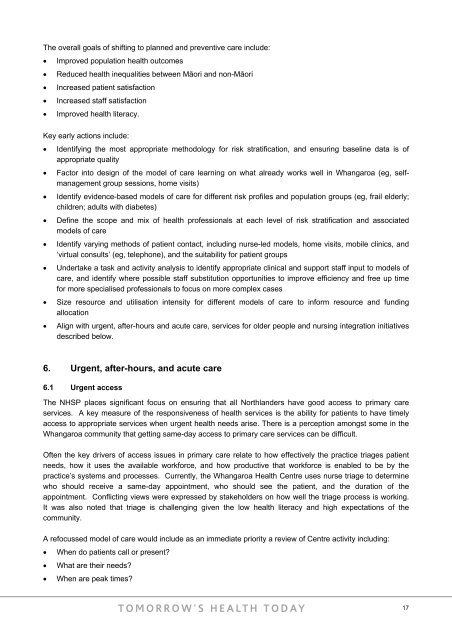Whangaroa Health Services Review Preferred Model of Care
Whangaroa Health Services Review Preferred Model of Care
Whangaroa Health Services Review Preferred Model of Care
Create successful ePaper yourself
Turn your PDF publications into a flip-book with our unique Google optimized e-Paper software.
The overall goals <strong>of</strong> shifting to planned and preventive care include: Improved population health outcomes Reduced health inequalities between Māori and non-Māori Increased patient satisfaction Increased staff satisfaction Improved health literacy.Key early actions include: Identifying the most appropriate methodology for risk stratification, and ensuring baseline data is <strong>of</strong>appropriate quality Factor into design <strong>of</strong> the model <strong>of</strong> care learning on what already works well in <strong>Whangaroa</strong> (eg, selfmanagementgroup sessions, home visits) Identify evidence-based models <strong>of</strong> care for different risk pr<strong>of</strong>iles and population groups (eg, frail elderly;children; adults with diabetes) Define the scope and mix <strong>of</strong> health pr<strong>of</strong>essionals at each level <strong>of</strong> risk stratification and associatedmodels <strong>of</strong> care Identify varying methods <strong>of</strong> patient contact, including nurse-led models, home visits, mobile clinics, and‘virtual consults’ (eg, telephone), and the suitability for patient groups Undertake a task and activity analysis to identify appropriate clinical and support staff input to models <strong>of</strong>care, and identify where possible staff substitution opportunities to improve efficiency and free up timefor more specialised pr<strong>of</strong>essionals to focus on more complex cases Size resource and utilisation intensity for different models <strong>of</strong> care to inform resource and fundingallocation Align with urgent, after-hours and acute care, services for older people and nursing integration initiativesdescribed below.6. Urgent, after-hours, and acute care6.1 Urgent accessThe NHSP places significant focus on ensuring that all Northlanders have good access to primary careservices. A key measure <strong>of</strong> the responsiveness <strong>of</strong> health services is the ability for patients to have timelyaccess to appropriate services when urgent health needs arise. There is a perception amongst some in the<strong>Whangaroa</strong> community that getting same-day access to primary care services can be difficult.Often the key drivers <strong>of</strong> access issues in primary care relate to how effectively the practice triages patientneeds, how it uses the available workforce, and how productive that workforce is enabled to be by thepractice’s systems and processes. Currently, the <strong>Whangaroa</strong> <strong>Health</strong> Centre uses nurse triage to determinewho should receive a same-day appointment, who should see the patient, and the duration <strong>of</strong> theappointment. Conflicting views were expressed by stakeholders on how well the triage process is working.It was also noted that triage is challenging given the low health literacy and high expectations <strong>of</strong> thecommunity.A refocussed model <strong>of</strong> care would include as an immediate priority a review <strong>of</strong> Centre activity including: When do patients call or present? What are their needs? When are peak times?17
















